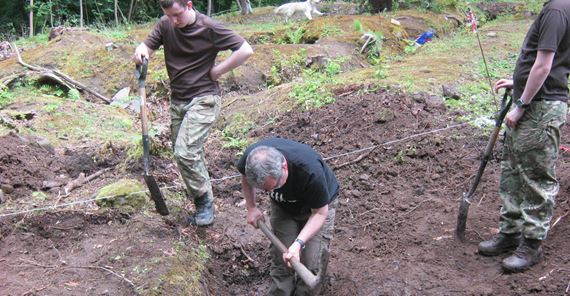Uncovering More About Military History in Scotland

Earlier this summer historic training trenches outside Edinburgh were the focus for an important archaeological excavation to provide a greater understanding of Scotland’s military history.
Thousands of local soldiers are understood to have prepared for battle on the Western Front by digging the trenches and undertaking battlefield drills at the site in Covenanters Wood in Dreghorn, which is owned by the Ministry of Defence, before leaving for the Battle of the Somme.
In July, specialists from the City of Edinburgh Council, AOC Archaeology and the Defence Infrastructure Organisation, part of the Ministry of Defence which manages and maintains the military estate and infrastructure, excavated five archaeological trenches in a bid to find out more about how and when they were used and the role they played in preparing soldiers for battle.
Miller Homes, which is building the nearby Polofields development, provided the majority of the funding for the excavations, which form part of a detailed woodland management plan being implemented by the housebuilder to ensure the 46 acre Covenanters Wood is effectively managed for the long term.
Colinton resident, Lynne Gladstone-Millar, recalls that her father trained within the trenches and their shape and layout, which the study revealed were shallower than expected at around one metre deep, clearly suggests that they have First World War origins.
Tom Lovekin from AOC Archaeology said: “Although finds from the trenches were comparatively limited, this actually gives us some insight into how they were used. It suggests that the Army kept the trenches clean and the troops did not camp out in them overnight.
“The depth of the trenches would have simply been too shallow to protect their occupants; however in many cases the ramparts which extended along the sides of the trenches would have increased the protection. These ramparts were created using the spoil generated during the excavation of the trenches. The sides of the trenches sloped inwards slightly so as to aid the troops ‘going over the top’.
“We did recover a single bullet casing from the fill of one of the trenches, which we believe is from Lee-Enfield rifle. This was the standard British infantry weapon from 1895 until 1957, which indicates that the trenches could have been used for training in preparation for both the First and Second World Wars.
“Roofing material within the dugout was painted with camouflage paint, intended to obscure the dugout from aircraft, which again also points to use during the Second World War. One of the visitors to the site reported that his father had trained in the Dreghorn trenches during his National Service, so we believe the Army utilised the trenches for training for a considerable period beyond the Armistice.”
Staff and cadets from the City of Edinburgh Universities Officer Training Corps and the Lothian and Borders Army Cadet Force were also involved in the study and members of the public volunteered to help with the excavations. Informal site tours were given to people walking within the woods.
David Morgan, Land Director at Miller Homes, said: “As part of our restoration of this historically important woodland we are delighted to see this archaeological study uncover information about our local military history in partnership with the Council and DIO. The study provided a great opportunity for residents and anyone with a keen interest in history to find out more from talks with AOC Archaeology and watch the digs as they took place.
“This survey has provided interesting findings which have widened our knowledge and understanding of Scotland’s military history.”
Councillor Richard Lewis, Culture Convener for the City of Edinburgh Council, said: “These woods are where local men prepared for life in the trenches and the study has been fundamental to helping us gain knowledge about the site. With the work of the DIO and AOC Archaeology and the support of Miller Homes we have been able to better understand the former training ground.”
Phil Abramson, a DIO archaeologist, said: “DIO has been involved in the Dreghorn trench project since 2012. The aim of the site study was to understand the type of training that took place, which units were involved in the training and when the trenches cease to be used, all of which were answered for us.”
